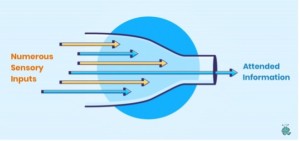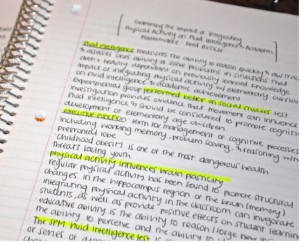Attention… what’s in a name?
Everyone knows what attention is. It is taking possession by the mind, in clear and vivid form, of one out of what seem several simultaneously possible objects or trains of thought. Focalization, concentration of consciousness are of its essence. It implies withdrawal from some things in order to deal effectively with others, and is a condition which has a real opposite in the confused, dazed, scatterbrain state.
– William James (1890)
As in William James’ description above, attention intuitively seems a pretty simple cognitive process. In the past three decades, neuroscience research has demonstrated that attention appears to be more complicated. If you look at the two neuroscience definitions below, the simple cognitive process doesn’t sound that simple anymore and comprises different complex processes.
Attention refers to all the mechanisms by which the brain selects information, amplifies it, channels it, and deepens its processing.
– Dehaene (2020:147)
Attention is the process by which certain information is selected for further processing and other information is discarded. Attention is needed to avoid sensory overload.
– Ward (2020:203)
Attention, attention!
It is impossible for the brain not to pay attention; it is always paying attention to something.
– Koenig (2010)
Our brain is always paying attention to something. I invite you to try not to pay attention to something. Even when we are, so to speak, “off in the clouds”, we are actually paying attention to something. There is always something we attend to. However, this also implies that we ignore other things in our immediate environment because we cannot pay attention to everything.
Attention is thus a fundamental mechanism in our brain. Without this mechanism, our brain would “crash” due to an overload of information. The cognitive process of attention ensures that certain information is given priority within the flow of information that enters our brain through our senses or that is activated by our thoughts. Or, to use two metaphors:
(1) attention is like a bottleneck because it limits the information flow to our brain;

(2) attention is like a text highlighter that makes important information in a text stand out.

What determines the priority
This can be anything. Very often, however, the priority is determined by our ongoing behaviour or a goal we are trying to achieve. For example, if you are thirsty and want a drink, your attention will first turn to the glass on the table so that you can grab it and fill it at the tap. Once you hold the glass, your attention shifts to the tap so that you can actually fill it, and so on. In this case, we speak of goal-driven control: your attention is directed by current behaviour or a goal. On the other hand, a random stimulus can catch your attention as well. This is called stimulus-driven control. This is the case, for example, when you suddenly hear a loud bang behind you and your attention is automatically drawn to it.
Conscious and unconscious attention
Attention is very often an unconscious process. Most of the time, we do not have to think about what to pay attention to. It just happens. In education, however, our students often have to direct their attention consciously, for instance, during class or when studying for an upcoming test or exam. Sustaining attention is energy-consuming and requires effort (sometimes, a lot).
Attention and learning
Of all the factors that influence learning, attention to the learned material may be the most important.
– Posner & Rothbart (2014:14)
The role of attention in memory encoding appears quite strong. For information to be properly encoded into memory, it is best for it be the target of attention.
– Lindsay (2020)
Without attention, learning is impossible because noticing, selecting and prioritizing task-relevant information are fundamental to the learning process. Only if our attention is focused on the right pieces of information, this information might be integrated and stored in neural networks in long-term memory to be remembered and retrieved later. Or, to put it differently: if attention is misdirected, learning can get stuck. (Dehaene, 2020:149).
Since attention determines what is learned, mobilizing our students’ attention is a priority. If we want our students to learn something, we must make sure that we draw their attention to the important things we want them to learn. So, as a teacher, it is crucial to think about how you can trigger, direct and maintain your students’ attention on what you want them to learn.
Quiz Summary
0 of 4 Questions completed
Questions:
Information
You have already completed the quiz before. Hence you can not start it again.
Quiz is loading…
You must sign in or sign up to start the quiz.
You must first complete the following:
Results
Results
0 of 4 Questions answered correctly
Your time:
Time has elapsed
You have reached 0 of 0 point(s), (0)
Earned Point(s): 0 of 0, (0)
0 Essay(s) Pending (Possible Point(s): 0)
Categories
- Not categorized 0%
- 1
- 2
- 3
- 4
- Current
- Review
- Answered
- Correct
- Incorrect
-
Question 1 of 4
1. Question
1. When we are “off in the clouds”, our brain stops paying attention.
CorrectIncorrect -
Question 2 of 4
2. Question
2. Fill in the missing words (everything, priority, certain information, ignore, by our thoughts, through our senses)
-
Attention ensures that is given within the flow of information that enters our brain or that is activated . This also implies that we other things in our immediate environment because we cannot pay attention to .
CorrectIncorrect -
-
Question 3 of 4
3. Question
3. Sudden and loud laughter behind you in the classroom catches your attention. This is an example of …
CorrectIncorrect -
Question 4 of 4
4. Question
4. If attention is misdirected, learning can get stuck.
CorrectIncorrect